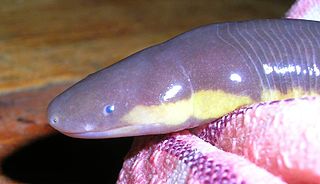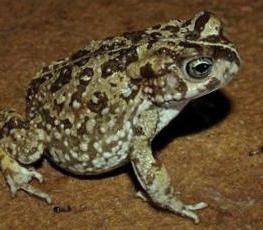
Caecilians are a group of limbless, vermiform or serpentine amphibians. They mostly live hidden in the ground and in stream substrates, making them the least familiar order of amphibians. All modern caecilians and their closest fossil relatives are grouped as a clade, Apoda, within the larger group Gymnophiona, which also includes more primitive extinct caecilian-like amphibians. Caecilians are mostly distributed in the tropics of South and Central America, Africa, and southern Asia. Their diet consists of small subterranean creatures such as earthworms.

Rhinatrematidae is a family of caecilians, also known as the Neotropical tailed caecilians, American tailed caecilians. or beaked caecilians. They are found in the equatorial countries of South America.

The Ichthyophiidae are the family of Asiatic tailed caecilians or fish caecilians found in South and Southeast Asia as well as southernmost China.

Uraeotyphlus is a genus of caecilians in the family Ichthyophiidae. There are seven species in this genus, all of which are endemic to the Western Ghats of southwestern India. Previously, the genus has also been placed in its own monotypic family Uraeotyphlidae.
The Scolecomorphidae are the family of caecilians, also known as tropical caecilians, buried-eyed caecilians, or African caecilians. They are found in Cameroon in West Africa, and Malawi and Tanzania in East Africa. Caecilians are legless amphibians which superficially resemble worms or snakes.

Caeciliidae is the family of common caecilians. They are found in Central and South America. Like other caecilians, they superficially resemble worms or snakes.

Typhlonectidae, also known as aquatic caecilians or rubber eels, are a family of Gymnophiona amphibians found east of the Andes in South America.
Rhinella pygmaea is a species of toad in the family Bufonidae. It is endemic to Brazil. Its natural habitats are subtropical or tropical moist lowland forests, subtropical or tropical moist shrubland, freshwater marshes, intermittent freshwater marshes, rural gardens, urban areas, and ponds. It is threatened by habitat loss.
Chthonerpeton arii is a species of amphibian in the family Typhlonectidae. It is endemic to Brazil. Its natural habitats are dry savanna, rivers, intermittent rivers, freshwater marshes, intermittent freshwater marshes, pastureland, irrigated land, seasonally flooded agricultural land, and canals and ditches.
Chthonerpeton braestrupi is a species of amphibian in the family Typhlonectidae.It is endemic to Brazil. Its natural habitats are rivers, swamps, freshwater marshes, intermittent freshwater marshes, pastureland, irrigated land, seasonally flooded agricultural land, canals and ditches.

Chthonerpeton exile is a species of caecilian in the family Typhlonectidae. It is endemic to Brazil, and only known from its imprecise type locality "Bahia". Only one specimen is known and now lost. The specific name exile, form Latin exilis, refers to the "relatively slender, delicate shape of the body and head." The common name Bahia caecilian has been coined for this species.

Chthonerpeton indistinctum is a species of caecilian in the family Typhlonectidae. It is found in northeastern Argentina, Paraguay, Uruguay, and southeastern Brazil. The common name Argentine caecilian has been coined for it.
Chthonerpeton noctinectes is a species of amphibian in the family Typhlonectidae, endemic to Brazil. Its natural habitats are subtropical or tropical seasonally wet or flooded lowland grassland, swamps, freshwater lakes, and pastureland.
Chthonerpeton onorei is a species of amphibian in the family Typhlonectidae, endemic to Ecuador. Its natural habitats are subtropical or tropical moist montane forests, rivers, swamps, freshwater marshes, intermittent freshwater marshes, pastureland, irrigated land, seasonally flooded agricultural land, and canals and ditches.
Chthonerpeton perissodus is a species of caecilian in the family Typhlonectidae. It is endemic to Minas Gerais, Brazil, and only known from its imprecise type locality, Rio Pandeiro. Only three specimens are known. The common name Minas Gerais caecilian has been coined for this species.
Chthonerpeton viviparum is a species of caecilian in the family Typhlonectidae. It is endemic to southern Brazil and only known from the vicinity of Joinville, in the eastern Santa Catarina State. The common name Santa Catarina caecilian has been coined for it.

Ingerophrynus is a genus of true toads with 12 species. The genus is found in southern Yunnan and Southeast Asia; from Myanmar and Indochina to peninsular Thailand and Malaya, Sumatra, Borneo, Java, Nias Island, Sulawesi, and the Philippines. This genus was established after a major taxonomical revision of frogs in 2006.

Poyntonophrynus, also known as pygmy toads, are a genus consisting of ten true toad species native to Sub-Saharan Africa. Originally, all Poyntonophrynus species were included in the genus Bufo. The genus was split due to large enough taxonomic divergence as evidenced by molecular markers. The genus is named in honour of John C. Poynton, South African herpetologist, with phrynus being Greek for toad.

Vandijkophrynus, also known as Van Dijk's toads, are a small genus of true toads, family Bufonidae. They are native to Southern Africa. The name commemorates Eddie Van Dijk, a South African herpetologist.











